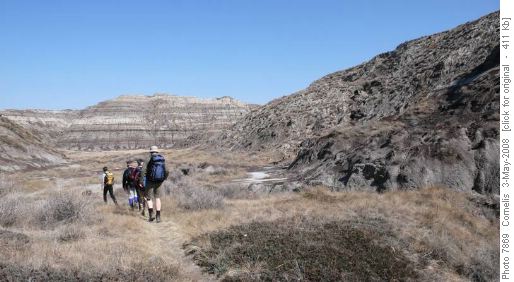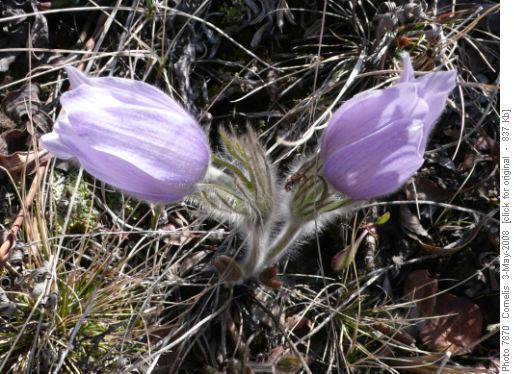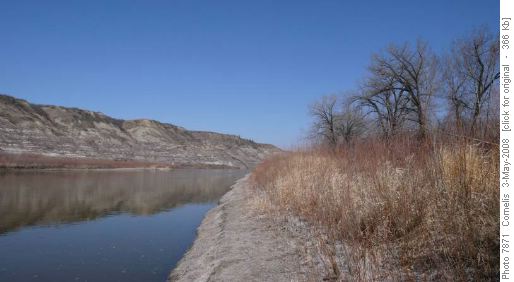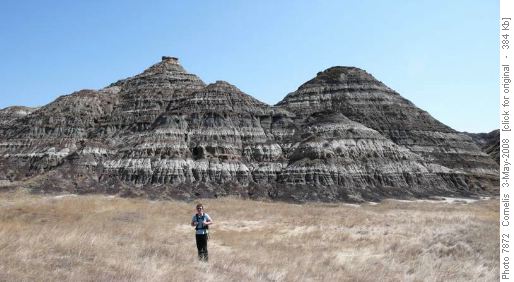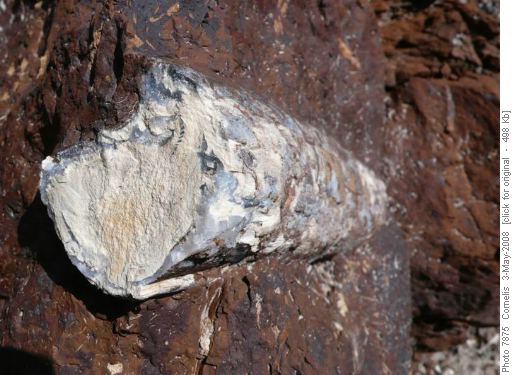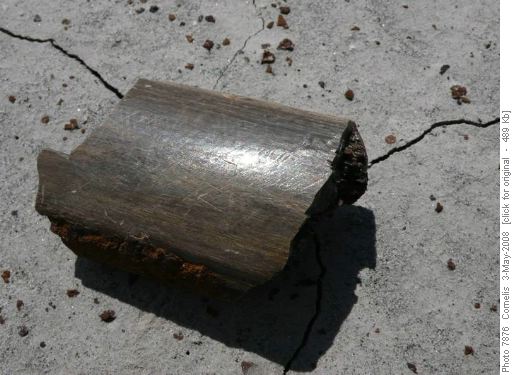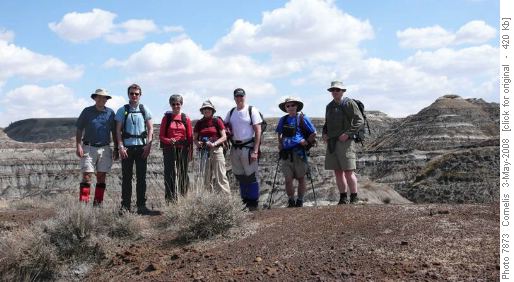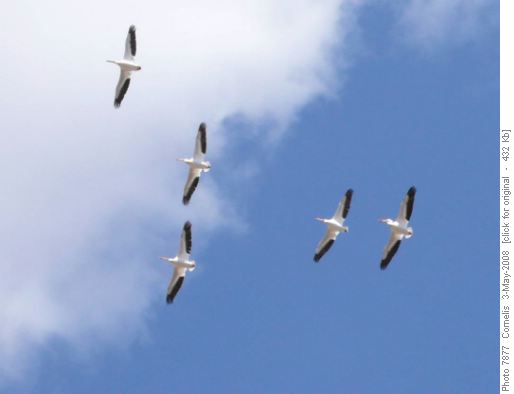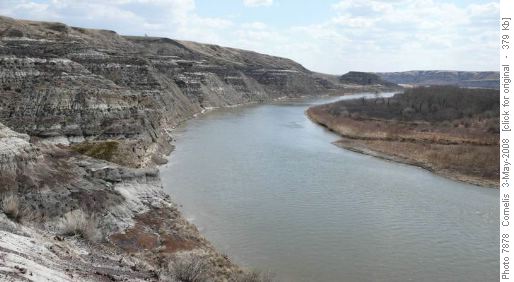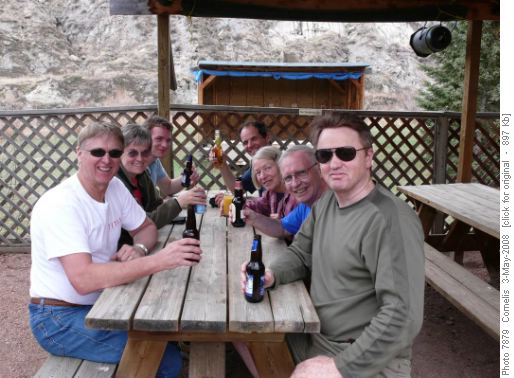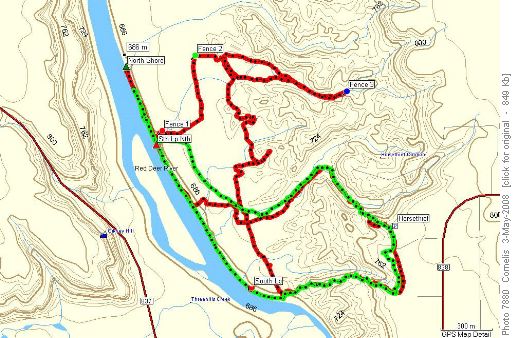Horse Thief Canyon - Red Deer River Loop & Wayne Off-Trail Hike on 3-
We made our way towards the river, emerging from the Canyon onto the river’s fescue grassed flood plain, with patches of Alberta’s Prickly Roses (Rosa Acicularis) and small disk-shaped Prickly Pear cactuses. Underfoot we crushed stunted but nevertheless budding Sagebrush (Artemisia Cana), releasing a pleasant lavender-like fragrance. Along the river stand old, spread-out cottonwoods. Barb found a large pheasant feather for her hat. Along the river’s edge are stands of thin, wispy willows (Salix family, aspirin for Beavers with tooth-ache), the prime food source for the area’s beavers and building material for a shaggy Beaver Lodge along the shore.
Well-worn beaver high-ways lead up the embankment into the willow stands. There was also evidence of otter activity along the embankment: discarded river clams and burrows. A woodpecker busily worked the old cottonwood’s trunks. Mallards and diving ducks scurried away and Canada Geese cruised overhead. We walked 900m north along the River bank, working our way around a flooded gully and a fence (a fence starts here, running North, gradually diverging from the river bank), turning back at the second flooded gully. We took a short and pleasant snack-break on the bank in the sun. Back at the first flooded gully, we headed 500m North on the floodplain until we hit a fence running East towards the canyon system.
Four White Tail deer fled towards the willow stands. We followed the fence until it ended against the canyon wall and entered the canyon. Here we found a large fossilized bone partly embedded in irondstone, which had rolled down the eroded canyon wall. (Could it have been a "Ramblero-Sauris"?? Old Ramblers never die, they slowly petrify). Looking up (approx. 2 meters), more fossils were visible.
We walked 800m deeper into the canyon, where it dead-ends at an old fence post. Here we turned back and had lunch where the canyon widens out onto the flood plain. The temperature rose to a comfy 20 degr. C. While we sat in the sun, we looked at the eroded stratified canyon walls, our windows into the past. Shortly after lunch we found another 4cm long piece of fossilized bone, similar to a rib, with its honey-combed internal pores still discernable. Its location was approx. 140m SE of our first find, on the opposite canyon wall.
We continued back South and crossed a canyon ridge into another canyon system. From the ridge we had a wonderful view of the canyons and the River and saw four more White Tail deer grazing in the canyon below. At this point we made our obligatory group picture. Descending from the ridge we continued south, cutting across the little creek of our entry-canyon. Above our heads appeared 12 large North American White Pelicans (Pelecanus Erythrorhynchos), with their huge orange-yellow bills. Their wings span up to 9.5 feet and have black tips and tailing edges. The pelicans were lazily circling on the thermals and descended a little to have a good look at us, before continuing on their track to the nesting grounds.
We continued our walk along the floodplain, until we reached Horse Thief’s most Southern canyon ridge, which runs to the river’s edge. We worked our way up the ridge (hiking due East), which provides excellent views of the Red Deer River running South towards Drumheller. South of this ridge the Red Deer River undercuts its bank, creating a near-vertical 80m high wall of soft, eroded sediment.
We were back at the car at 2:30PM, after a very satisfying hike. The distance and elevation (9.5km, elevation between the 785m and 685m above sea-level) were not sufficient to provide any bragging-rights, but the scenery, wildlife (both modern and ancient), wonderful views and summer temperatures more than made up for that. But the day was not over yet! We drove to the ancient coal mining-ghost town of Wayne, all the way up a narrow coulee, crossing 9 bridges (a great countdown to great burgers and cold beer) until we reached the 95-year old wild-west style Rosedeer Hotel and the "Last Chance" Saloon, where we enjoyed cold beer and hearty hamburgers. Thanks to all the Ramblers who joined me on this naturalists’ dream-trip!
Participants: Larry, Rita, Carl, Barbara, Jim, Danker & Cornelis (Coordinator, Scribe and Pictures).
Note on Bentonite Clay: Bentonite Clay is 70-million year old weathered volcanic ash, deposited in a saline Cretaceous sea. The weathered bentonite clay mineral is called Montmorillonite (Na,Ca)0.33(Al,Mg)2Si4O10(OH)2.nH2O, which can absorb an amount of water 10x its dry volume. When dry, it has a popcorn-like texture. Bentonite clay is used as a sealant when drilling oil wells and has many other industrial applications. The Bentonite deposits from the Drumheller area are not pure enough for these applications.
Map of the Horse Thief Canyon and Read Deer River hike & explore options.The Red trip was hiked on May 3rd, 2008. (The Green trip was a private trip October 7th, 2007) This is a wonderful area to explore in the early season or when the autumn colors are golden.
